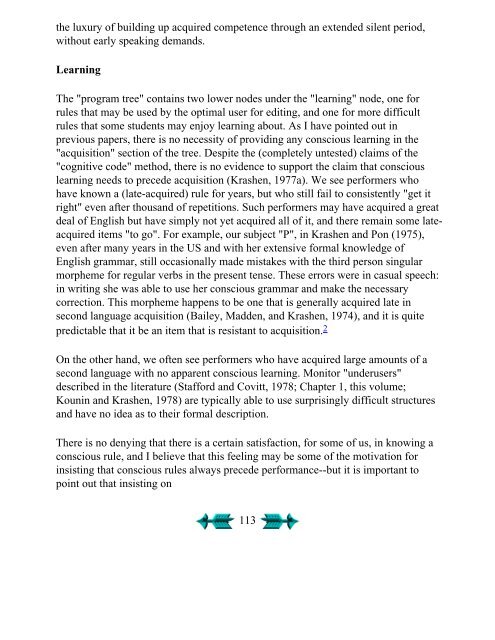Second Language Acquisition and Second ... - Stephen Krashen
Second Language Acquisition and Second ... - Stephen Krashen
Second Language Acquisition and Second ... - Stephen Krashen
You also want an ePaper? Increase the reach of your titles
YUMPU automatically turns print PDFs into web optimized ePapers that Google loves.
the luxury of building up acquired competence through an extended silent period,<br />
without early speaking dem<strong>and</strong>s.<br />
Learning<br />
The "program tree" contains two lower nodes under the "learning" node, one for<br />
rules that may be used by the optimal user for editing, <strong>and</strong> one for more difficult<br />
rules that some students may enjoy learning about. As I have pointed out in<br />
previous papers, there is no necessity of providing any conscious learning in the<br />
"acquisition" section of the tree. Despite the (completely untested) claims of the<br />
"cognitive code" method, there is no evidence to support the claim that conscious<br />
learning needs to precede acquisition (<strong>Krashen</strong>, 1977a). We see performers who<br />
have known a (late-acquired) rule for years, but who still fail to consistently "get it<br />
right" even after thous<strong>and</strong> of repetitions. Such performers may have acquired a great<br />
deal of English but have simply not yet acquired all of it, <strong>and</strong> there remain some lateacquired<br />
items "to go". For example, our subject "P", in <strong>Krashen</strong> <strong>and</strong> Pon (1975),<br />
even after many years in the US <strong>and</strong> with her extensive formal knowledge of<br />
English grammar, still occasionally made mistakes with the third person singular<br />
morpheme for regular verbs in the present tense. These errors were in casual speech:<br />
in writing she was able to use her conscious grammar <strong>and</strong> make the necessary<br />
correction. This morpheme happens to be one that is generally acquired late in<br />
second language acquisition (Bailey, Madden, <strong>and</strong> <strong>Krashen</strong>, 1974), <strong>and</strong> it is quite<br />
predictable that it be an item that is resistant to acquisition. 2<br />
On the other h<strong>and</strong>, we often see performers who have acquired large amounts of a<br />
second language with no apparent conscious learning. Monitor "underusers"<br />
described in the literature (Stafford <strong>and</strong> Covitt, 1978; Chapter 1, this volume;<br />
Kounin <strong>and</strong> <strong>Krashen</strong>, 1978) are typically able to use surprisingly difficult structures<br />
<strong>and</strong> have no idea as to their formal description.<br />
There is no denying that there is a certain satisfaction, for some of us, in knowing a<br />
conscious rule, <strong>and</strong> I believe that this feeling may be some of the motivation for<br />
insisting that conscious rules always precede performance--but it is important to<br />
point out that insisting on<br />
113











